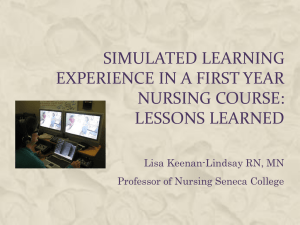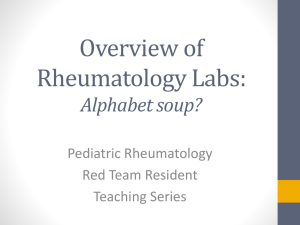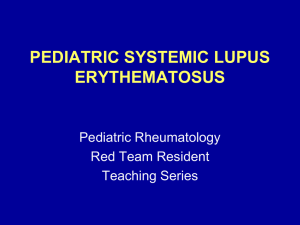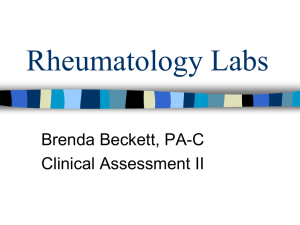Rapamycin as an Immunomodulator in Systemic Lupus Erythematosus
advertisement
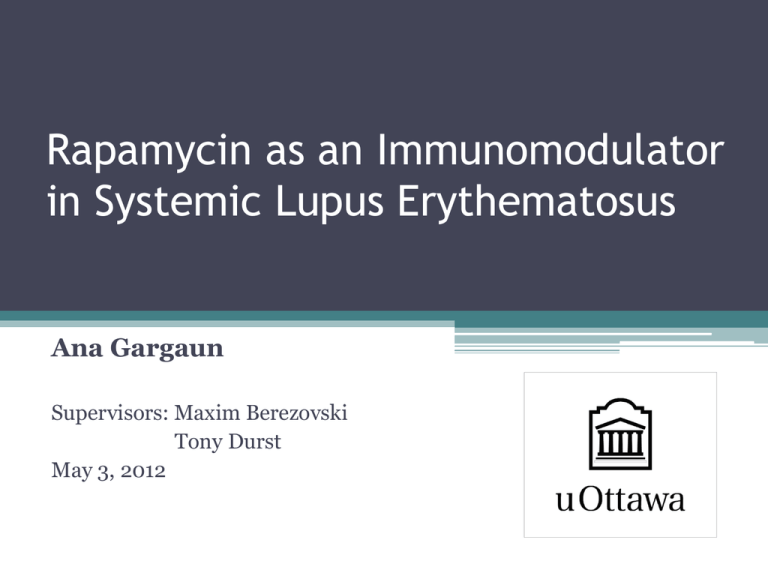
Rapamycin as an Immunomodulator in Systemic Lupus Erythematosus Ana Gargaun Supervisors: Maxim Berezovski Tony Durst May 3, 2012 2 • Systemic Lupus Erythematosus (SLE) • Rapamycin Biosynthesis • Rapamycin • Rapamycin Synthesis 3 Systemic Lupus Erythematosus (SLE) 19th century • Skin lesions 20th century • Systemic autoimmune disease Malar rash • SLE is a multifactorial, heterogeneous group of diseases which may be fatal and can be characterized by anti-nuclear autoantibody production, resulting in organ failure Talaber G, Perl A (2011) SLE: a Metabolic Disease of T Cells? Rheumatology 1:e103 4 Epidemiologic Factors • Female to male ratio ▫ 10 to 1 between the ages of 15-45 • In Canada, the SLE prevalence is 0.05% overall ▫ Often misdiagnosed • Varies with race, ethnicity, and socioeconomic status ▫ African-Americans and Asians More common and severe N.T. Colburn, Review of Rheumatology, © Springer-Verlag London Limited 2012 5 American College of Rheumatology Criteria for the Diagnosis of SLE • 11 criteria used to establish the disease, with 4 needed for the formal diagnosis of SLE I. Malar rash II. Discoid rash III.Photosensitivity IV. Oral ulcers V. Arthritis VI. Serositis VII. Kidney disorder VIII.Neurologic disorder IX. Blood disorder X. Immunologic disorder XI. Abnormal antinuclear antibodies http://emedicine.medscape.com/article/332244-workup 6 Overview of the Etiology & Pathogenesis of SLE Tsokos, G.C. N Engl J Med 2011; 365:2110-21 7 Overview of the Etiology & Pathogenesis of SLE • Familial aggregation • Defect in apoptosis ▫ Disturbance in immune tolerance • Genes responsible for “waste disposal” ▫ C1q Tsokos, G.C. N Engl J Med 2011; 365:2110-21 8 Overview of the Etiology & Pathogenesis of SLE • Exposure to UV light Keratinocytes Apoptosis • Viruses (e.g. Epstein-Barr virus) ▫ Cross reactivity of foreign antibody to self antigen Tsokos, G.C. N Engl J Med 2011; 365:2110-21 9 Overview of the Etiology & Pathogenesis of SLE • Major factor • Antigen-driven B Cell proliferation • B Cell hyperactivity ▫ Heightened responses Both self and foreign antigens • Abnormal tolerance Tsokos, G.C. N Engl J Med 2011; 365:2110-21 ▫ Normally precursors to autoantigens are tolerated ▫ SLE retains precursors that produce high affinity autoantibodies 10 Overview of the Etiology & Pathogenesis of SLE • Estrogen ▫ Prepubertal and postmenopausal women have similar incidence to men ▫ Men with SLE have higher concentration of estrogenic metabolites ▫ Pregnancy may aggravate symptoms of SLE ▫ Hormone replacement therapy Tsokos, G.C. N Engl J Med 2011; 365:2110-21 11 Overview of the Etiology & Pathogenesis of SLE • DNA methylation • Hypomethylation is present in SLE • Drug induced lupus ▫ ▫ Tsokos, G.C. N Engl J Med 2011; 365:2110-21 E.g. hydralazine Reversible 12 Autoimmunity in SLE Autoimmunity: A condition in which the body's immune system produces antibodies in response to its own tissues or blood components instead of foreign particles or microorganisms. Impaired tolerance Hyperactive B-cell T-cell activation Defective immune complex clearance N.T. Colburn, Review of Rheumatology, 2012 © Springer-Verlag London Limited Gale Encyclopedia of Medicine. Copyright 2008 The Gale Group, Inc. 2008 13 Interaction between a T Cell and an AntigenPresenting Cell (APC) Antigen Presenting Cell: B-Cell, Dendritic Cell, or Macrophage Rahman, A et al. N Engl J Med 2008; 358: 929-39. 14 T-cell and B-cell Co-Stimulation Rahman, A et al. N Engl J Med 2008; 358: 929-39. 15 Pathogenic Autoantibodies in SLE Antigen Specificity Prevalence (%) Main Clinical Effects dsDNA 70-80 Kidney disease, skin disease Nucleosomes 60-90 Kidney disease , skin disease Ro (RNP) 30-40 Skin disease, kidney disease, fetal heart problems La (RBP) 15-20 Fetal heart problems Sm (snRNP) 10-30 Kidney disease NMDA receptor 33-50 Brain disease Phospholipids 20-30 Thrombosis, pregnancy loss Rahman, A et al. N Engl J Med 2008; 358: 929-39. 16 Treatments • Anti-malarials • E.g. Hydroxychloroquine • NSAIDs • E.g. Ibuprofen • Immunosuppressive agents • E.g. Methotrexate • Glucocorticoids • E.g. Prednisone • Cell signaling modulators • E.g. Rapamycin 17 Survival rate • 1950s ▫ 5 year survival rate was 50% • Today ▫ 15 year survival rate of 80% ▫ Patients diagnosed at 20 years of age, have a 1 in 6 chance of dying by 35 years of age from lupus or infection Tsokos, G.C. N Engl J Med 2011; 365:2110-21 18 Rapamycin Found in a soil sample from Streptomyces hygroscopicus from Easter Island, also known as Rapa Nui, in 1975 • Gram-positive • Aerobic • Filamentous 19 Rapamycin (RapamuneTM) • Currently in clinical trials for SLE Andras Perl, MD/PhD David Fernandez, MD/PhD Candidate Michigan Upstate University • Immunosuppressant used to prevent rejection during organ transplant ▫ Approved by the FDA in 1999 and is marketed as Rapamune by Pfizer (formerly Wyeth) • Potent antifungal and anticancer agent 20 Mechanism of Action of Rapamycin • FKBP is an immunophilin • mTOR (mammalian Target of Rapamycin) • is a serine threonine kinase • mTORC1 and mTORC2 Park, S. R., et al. Journal of Antibiotics. 2010. 63, 434-441 21 Mechanism of Action of Rapamycin Kd FKBPRapamycin 0.2nM FKBPRapamycinmTOR 2.5nM FKBP binding Kd RapamycinmTOR 260.8M FKBPRapamycinmTOR 120.8nM mTOR binding Banaszynski, L.A., et al. J. Am. Chem. Soc. 2005, 127, 4715-4721 22 Sourcing Rapamycin, RapamuneTM • How is it made on a commercial scale? ▫ Fermentation of S. hygroscopicus ▫ $388 million in revenue for Pfizer in 2010 • Oral solution (5mg) and tablets (0.5mg, 1mg, 2mg) • How much does it cost? ▫ ~$1,200/90 2mg tablets ▫ Dosage for organ transplants: 2mg/day 23 Biosynthesis of Rapamycin by S. hygroscopicus PKS RapA RapB Raps1 Raps2 RapC Raps3 NRPS Rap P PIE 15 modules: 70 catalytic sites Schwecke et al. Proc. Natl. Acad. Sci. 1995 USA Vol. 92 pp. 7839-7843 Post PKS and NRPS oxygenases, MT, and other 24 Biosynthesis of Rapamycin: PKS 13 modules, 57 steps using the enzymes: KS, AT, ACP ER, KR, DH , using malonate or methyl malonate 25 Biosynthesis: Cyclization and Modifications 26 Rapamycin: Synthesis • 31 membered ring • Many stereocenters • Labile bonds • Total Synthesis: ▫ K.C. Nicolaou ▫ S. J. Danishefsky ▫ A. B. Smith 27 Retrosynthetic Analysis of Rapamycin by K.C. Nicolaou + 28 Forward Synthesis of Rapamycin by K.C. Nicolaou 95% yield 29 Forward Synthesis of Rapamycin by K.C. Nicolaou 70% yield 30 Forward Synthesis of Rapamycin by K.C. Nicolaou 28% yield • Longest linear sequence from 5 sub targets is 16 steps • Total number of steps 102 31 Conclusion • “Pathophysiology of SLE is enigmatic, potentially deadly, and it is yet unsolved” • Pathogenic autoantibodies are the primary cause of tissue damage in patients with lupus • Many different elements of the system are potential targets for therapeutic drugs in patients with SLE 32 Conclusion continued • Rapamycin is in clinical trials for patients with severe cases of SLE • Its biosynthesis involves elaborate enzyme complexes • Polyketide synthase and Non-Ribosomal Peptide Synthetase • Its total synthesis is an impressive challenge for any chemist 33 Acknowledgements Dr. Maxim Berezovski Dr. Tony Durst The Berezovski Lab The Durst Lab NSERC CREATE Questions?


